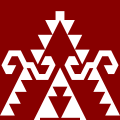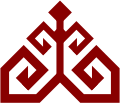Elibelinde
Elibelinde (Turkish for “ the hands on the hips ”) is the name of a common motif on Turkish flat woven fabrics and knotted carpets , which in various forms is reminiscent of a female figure. The arms of the figure are represented by two hooks pointing inwards, the body of the woman generally by a triangle or a rhombus, and her head usually by a rhombus on the tip. The Elibelinde motif was viewed as a fertility and mother symbol before it was proven that this interpretation was based on scientific forgery.
Origin of the interpretation as a fertility symbol
The interpretation as a symbol of fertility goes back to an ultimately unproven claim made by the British archaeologist James Mellaart in 1967. As one of the excavators of the Neolithic settlement of Çatalhöyük , which dates back to around 7000 BC. Mellaart published drawings of wall paintings. He claimed to have made them before the paintings faded after they were exposed. Mellaart's drawings are similar to 19th century Turkish flat woven patterns. He interpreted the forms, which were reminiscent of a female figure, as evidence of the cult of a "mother goddess" in Çatalhöyük, which he saw represented in the Elibelinde motif. Mellaart's claims have been refuted by other archaeologists and knowledgeable weavers.
Art-historical interpretive approaches
The art historian Walter B. Denny understands the Elibelinde pattern as a stylized carnation blossom, the development of which he derives in detail and in uninterrupted lines from Ottoman court carpets of the 16th century. Brüggemann and Boehmer understand the motif based on their pattern structure analyzes as the “upper and lower vertical cross arm of the Anatolian form of the Yün-chien”, the Chinese “cloud collar” motif.
Popular culture
Although the interpretation of the Elibelinde motif as mother goddess arose from a scientific falsification, the cult recognized as fictitious is still the subject of popular literature and can therefore be compared with religious parodies.
literature
- Celal Özcan : Hoş Geldin, welcome. Deutscher Taschenbuch Verlag, Munich 2003, ISBN 3-423-09424-9 .
- Mehmet Ateş: Mitolojiler semboller ve halılar, koç boynuzu-elibelinde. Symbol Yayıncılık, Istanbul 1996, ISBN 975-96101-5-9 .
Web links
- https://www.kilim.com/kilim-wiki/kilim-motifs
- http://www.dervishbrothers.com/kilimsymbology/Kilimingilizce.pdf
- http://www.uludagsozluk.com/k/elibelinde
- dipnotkitap.net
Individual evidence
- ^ RH Dyson, James Mellaart: Catal Huyuk. A Neolithic Town in Anatolia . In: Science . tape 157 , no. 3795 , September 22, 1967, p. 1419-1420 , doi : 10.1126 / science.157.3795.1419 .
- ^ Oriental Rug Review. Vol. 10, No. August 6 / September 1990.
- ^ Walter B. Denny: How to Read Islamic Carpets . 1st edition. Yale University Press, New Haven / London 2014, ISBN 978-1-58839-540-5 .
- ↑ Werner Brüggemann, Harald Boehmer: Carpets of the farmers and nomads in Anatolia . 2nd Edition. Verlag Kunst und Antiquitäten, Munich 1982, ISBN 3-921811-20-1 , p. 234 .
- ↑ Celal Özcan : Hoş Geldin, a warm welcome. Deutscher Taschenbuch Verlag, Munich 2003, p. 65.
- ^ Uta Francine Vogel: Wilhelmine. The art of creating a life . Pro Business GmbH, Berlin 2009, ISBN 978-3-86805-347-0 , p. 9 .



